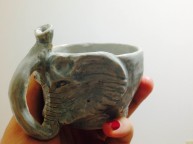For my Community Involvement Project, I had the opportunity to dance at Fly Dance Studio in Kyoto. I have been dancing for over 10 years and I want to work in the dance industry in the future, so I wanted to participate in the performing arts scene in Japan. Fly Dance Studio specializes in Hip-Hop, so I had the chance to improve my skills in this style. I grew stronger and learned a lot in terms of technique, and I was able to step out of my comfort zone in using and understanding Japanese.
One of the first things that stood out to me the most was how dancers greeted each other when they entered the studio. Everyone said “ohayou gozaimasu” even though the studio opens at 4pm. At first I was confused, but soon learned that this is common in the performing arts world in Japan. The hiphop culture at this studio was more westernized than I expected, with English songs being used a lot more than Japanese songs, and everyone dressed in western-style dance wear. The rap industry is huge in America, which is likely the reason these English songs are used for more upbeat choreography. However, in the Jazz Hiphop classes that were much slower and more lyrical, Japanese songs were more frequently used. I learned lots of vocabulary related to movement and body parts. Because my teachers were both men and women, I had the opportunity to practice listening to various genders and their way of speaking. Some teachers were easier to understand than others, but overall I felt myself improving a lot in my listening comprehension and understanding of Kansai dialect.
Perhaps another interesting feature of this studio is that it does not separate by age. In the United States, it is common to have separate classes for adults, kids, and teens, but there were large age gaps in all of my classes at Fly, so some people were as young as seven or eight-years-old or as old as 60. Even though it can be difficult for the teacher to adjust to student gaps in dance experience and physical ability, as a student it felt very welcoming to be able to take the same class regardless of age. Everyone learned at their own pace and was able to adjust the choreography based on their own physical abilities.
Fly Dance Studio will work you hard, but you will get better. The instructors are very good at what they do; there was not a single class that I did not enjoy, and the level was perfect for me. If you do not have any dance experience, I would recommend sticking to the very beginner classes, but do not be afraid to challenge yourself with the more advanced classes!

